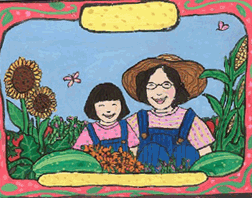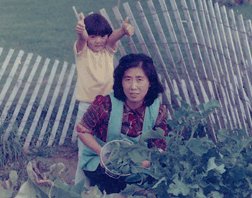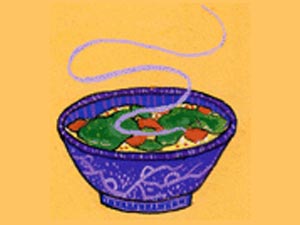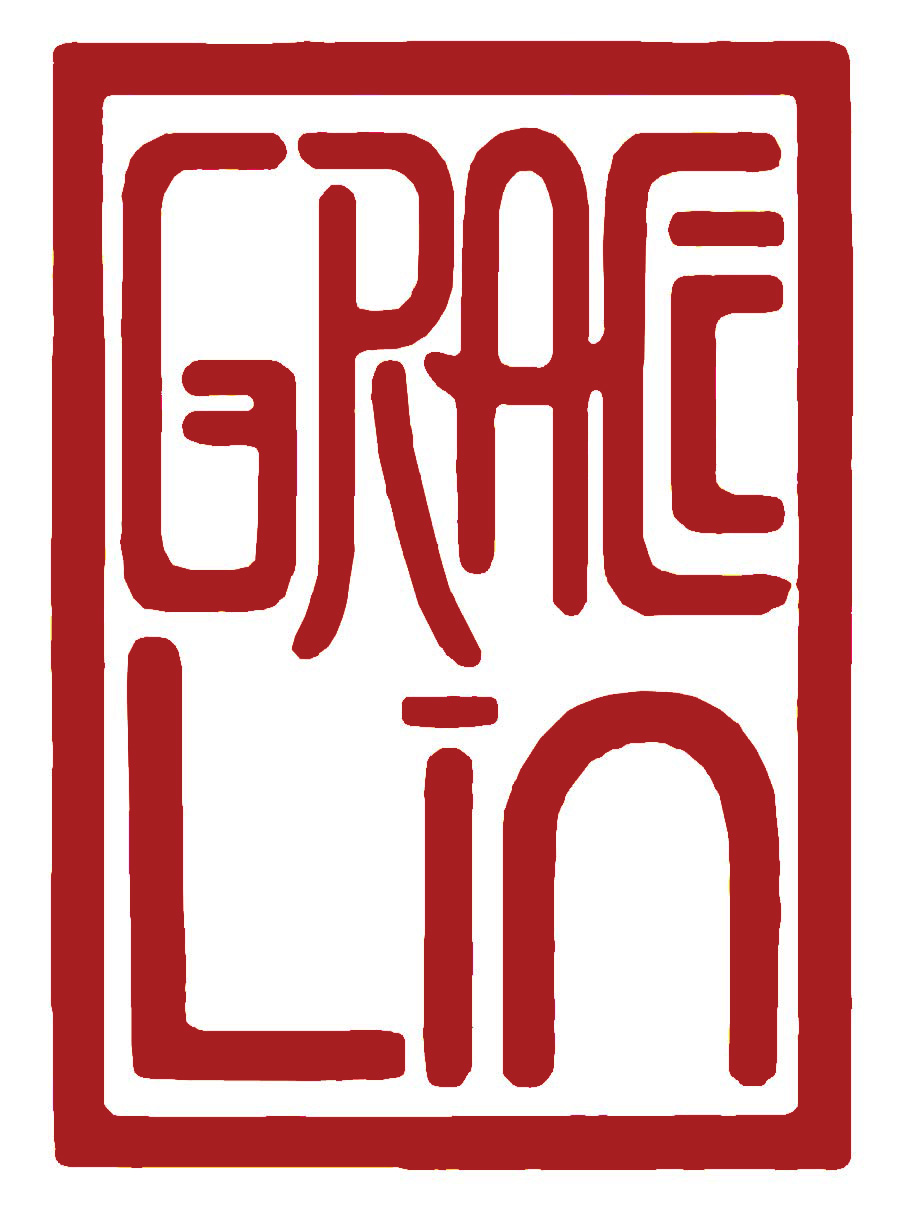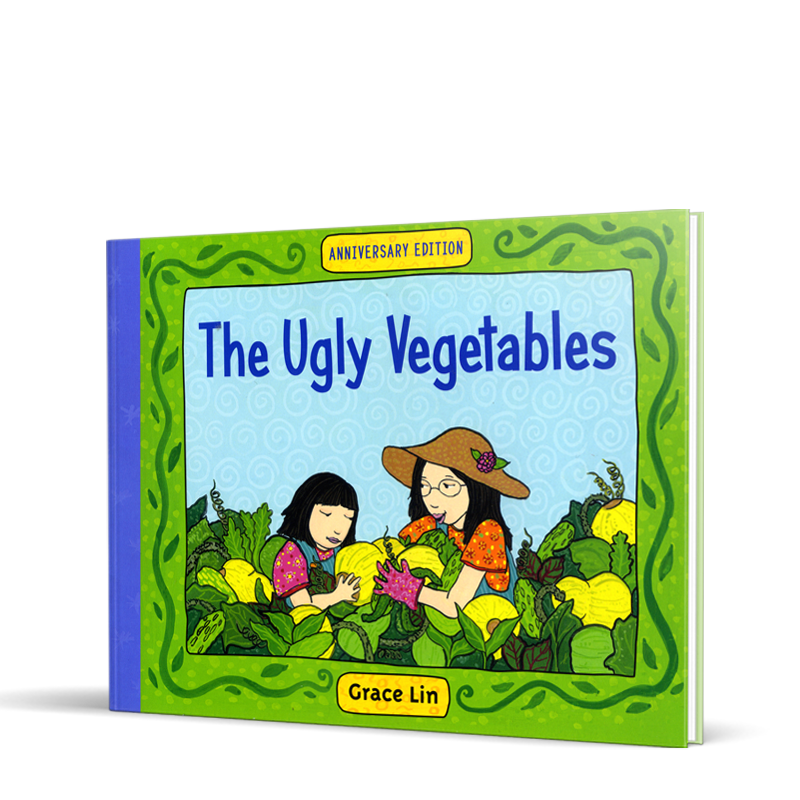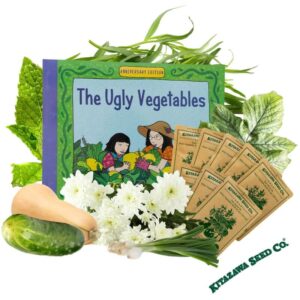From Kirkus Reviews
A savory story time companion to Helena Clare Pittman and Victoria Raymond’s Still-life Stew (1998). In a bright landscape of small houses and backyards, a girl and her mother dig a garden, as do her neighbors. The green shoots come up and grow, and the daughter notices that while the neighbors are cultivating flowers that fill the air with sweetness, her mother is growing ugly dark green leafy things. They are labeled not with pretty seed packages but with Chinese characters. At the end of the season, her mother picks the vegetables, and makes them into a soup that smells so good it brings all the neighbors to their porches looking as if “they were trying to eat the smell.” They come to the girl’s house bearing flowers, and mother and daughter invite them to share the soup. The next year, mother and daughter grow a few flowers alongside their vegetables, and the neighbors have small plots of vegetables next to their flower beds The gouache paintings emphasize pattern: florals, grasses, stripes and dots on clothing and rooftops. The colors are of a sunny world, with an emphasis on rose, purple, brown and a multitude of greens. Pictures of all the vegetables with their Chinese and English names along with the soup recipe are included. Lin tells her charming story simply, and the pictures reflect its many joys. Picture book.
From Horn Book
While the gardens in her suburban community look like “rainbows of flowers,” and “the wind always smelled sweet,” the unnamed narrator is disappointed with her family’s Chinese vegetable garden. All she sees are “lumpy,” “icky yellow,” and “thin and green” vegetables, and she wonders why her family doesn’t grow flowers instead. Her mother patiently reassures her that the ugly vegetables are better than flowers, telling her to “wait and see.” As the plants grow and finally produce vegetables, readers experience vicariously the simple pleasures of gardening. The simply-told first-person text is well matched with the lively, color-saturated paintings. With slightly distorted, flattened perspectives and rounded, comforting shapes, Lin’s style borders on the naive with a fresh folk-like quality. Each page bristles with movement enhanced by pattern: swirls of blue in the sky; variegated brown and green hues of the trees; imaginative designs on fabric; even the washes of background color on which many of the paintings are set are lightly decorated with such motifs as vine, seed, leaf or flower shapes, adding energy to the design and the illustrations. Most readers will identify with the narrator’s feeling of mild discontent about her family’s differences, and some will be introduced to another culture and cuisine. After the vegetables have been harvested, there’s a new scent in the air: ugly vegetable soup, which, the young girl says, “seemed to dance in my mouth and laugh all the way down to my stomach.” A final page features a glossary/pronunciation guide for the vegetables’ names in Chinese as well as a soup recipe. Grace Lin’s debut picture book serves up the savory delights of the harvest in a satisfying story.
From School Library Journal Review
A Chinese-American girl and her mother grow a vegetable garden in a neighborhood where everyone else grows flowers. The girl thinks their plants are ugly compared to flowers, but soon learns that vegetables can make a very delicious soup – one that the whole neighborhood wants to try. Soon everyone is growing Chinese vegetables as well as flowers. A recipe for “Ugly Vegetable Soup” is included. Lin’s brightly colored gouache illustrations perfectly match her story, creating a patchwork-quilt effect as the neighbors’ backyards all converge. Families of all kinds engage in all sorts of activities while children play happily together. Each double-page spread is a different color with a different pattern scattered lightly across it, serving as a frame for the illustrations and as background for the text. A lovely, well-formatted book with an enjoyable multicultural story.
From Booklist Review
While the neighbors’ gardens burgeon with bloom, a troubled child sees nothing but wrinkled leaves and dark vines growing in hers. She doubts her mother’s claim that what she is growing is actually better than flowers – until the harvested sheau hwang gua, torng hau, and other Chinese vegetables have been chopped into the soup pot, and neighbors, drawn by the delicious smell, appear at the door with armloads of flowers and big appetites. Filling spaces with curlicues and dabs of color, Lin places her characters in a tidy suburban setting replete with happy families playing on unfenced, wildflower-dotted lawns. Closing with a recipe and glossary, this brief consciousness raiser makes a mouth-watering companion for Rosemary Wells’ Yoko (1998) or books like Nora Dooley’s multicultural standby, Everybody Cooks Rice (1991).
From Children’s Literature
A young girl is excited, because she is helping her mother plant a garden in the spring, but she is not happy with what is being planted. All the other neighbors are planning to raise pretty flowers, but her mom is planting “ugly” vegetables. They are Chinese vegetables, which are all lumpy and hairy and not very nice to look at – but they taste great, as the girl finds out when her mother harvests the garden and makes a delicious soup. The neighbors smell the wonderful aroma and bring the girl and her family lovely flowers from their gardens in exchange for a taste of the mouth-watering soup. Finally, all the neighbors sit down to a wonderful dinner together. The following spring, everyone in the neighborhood plants pretty flowers and Chinese vegetables. At the very end of the book, readers will find an “ugly vegetable” glossary and the recipe for Ugly Vegetable Soup. This is a great book to help defuse kids’ anxiety about differences of any kind.
